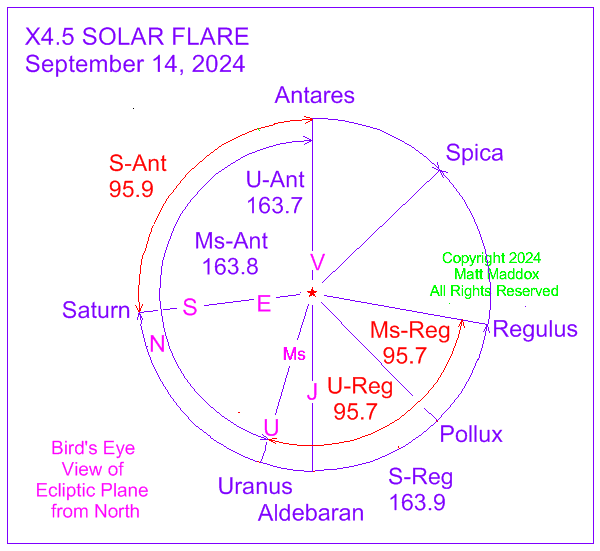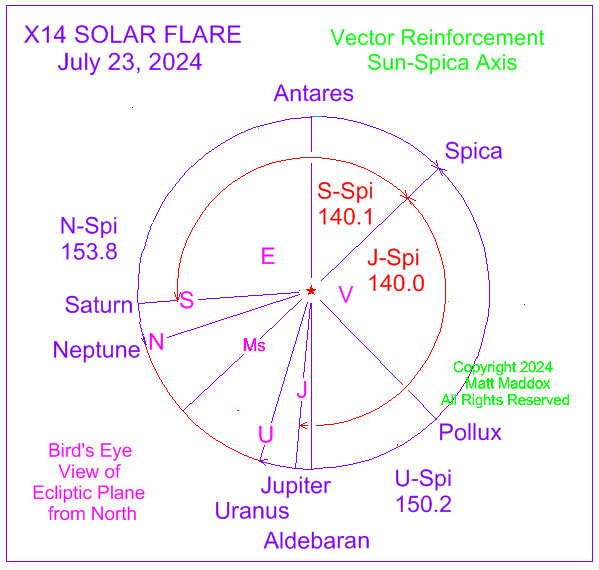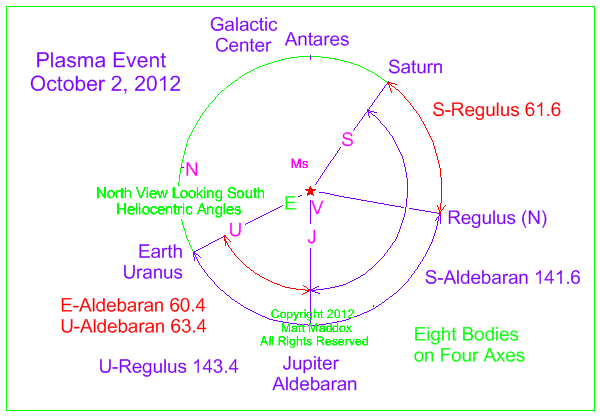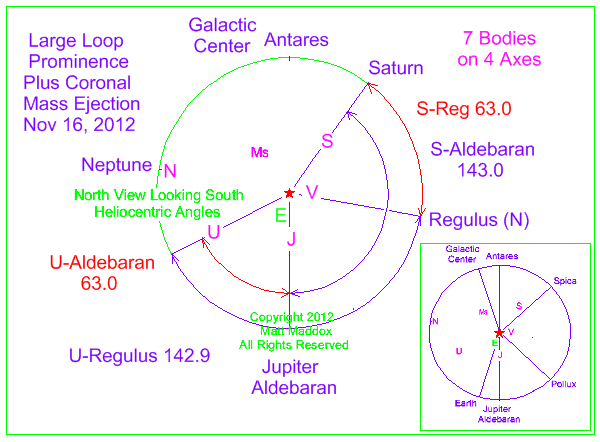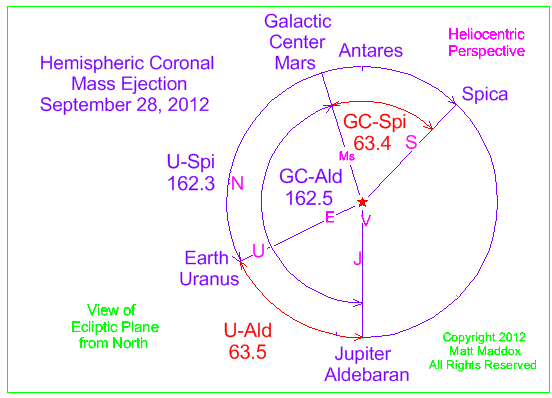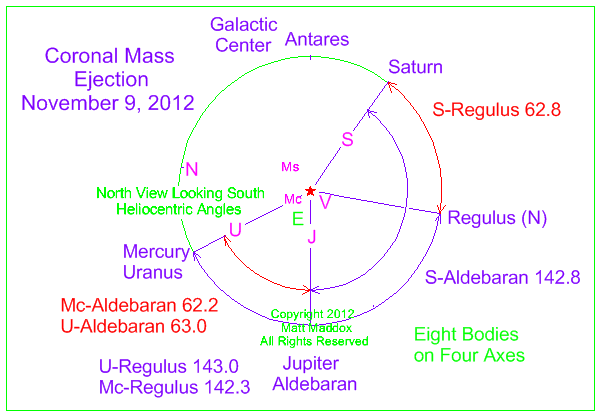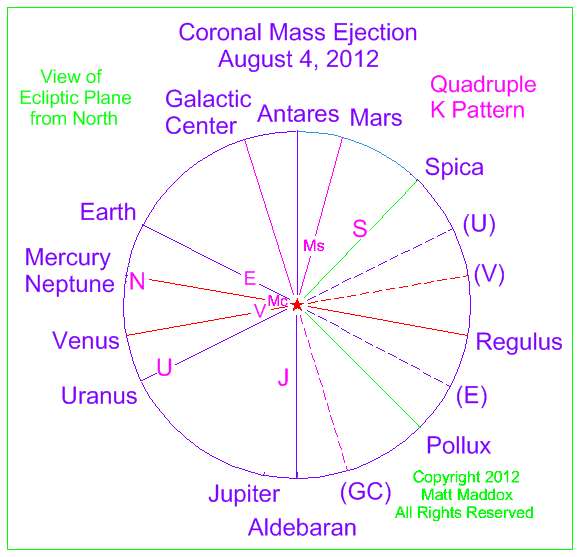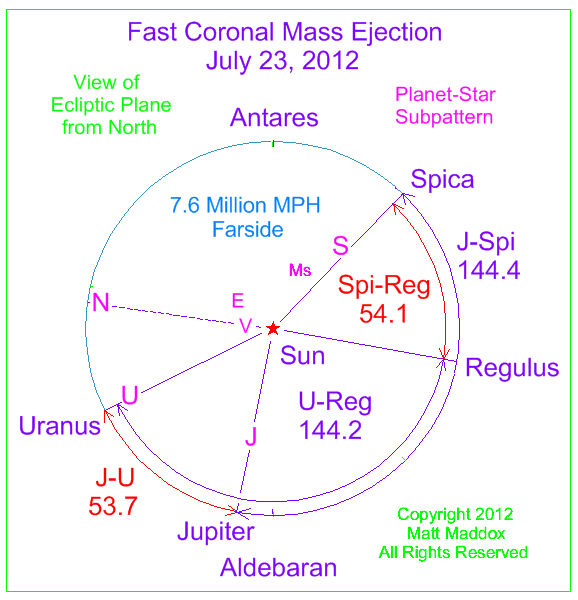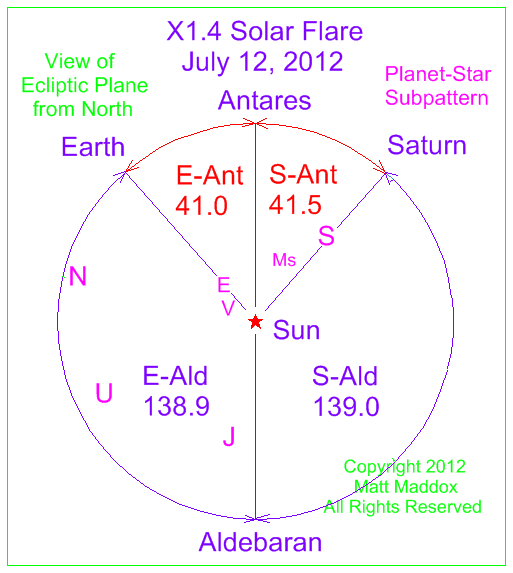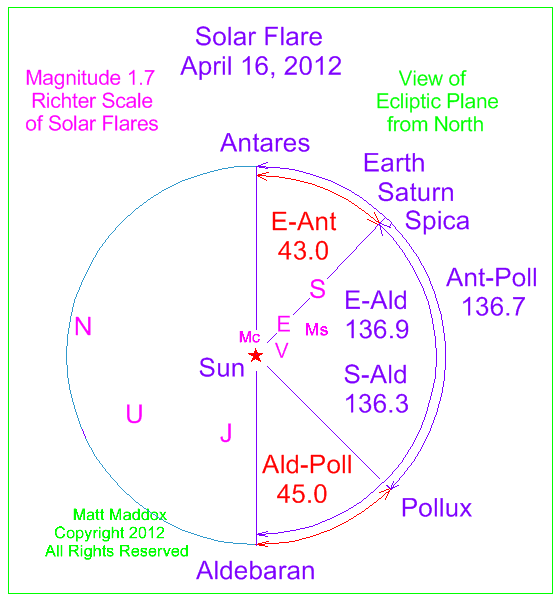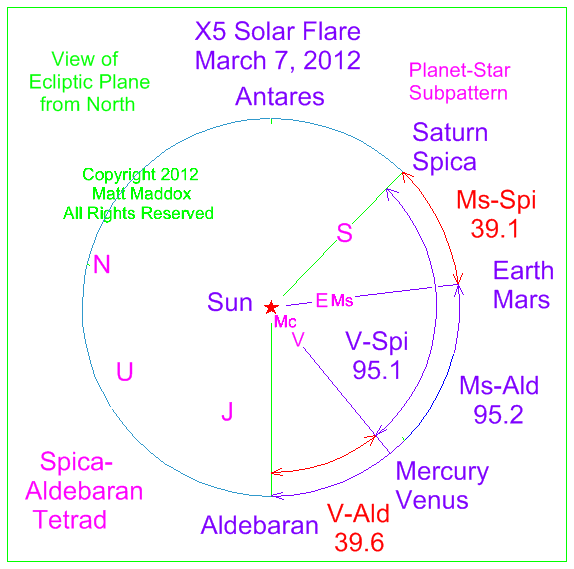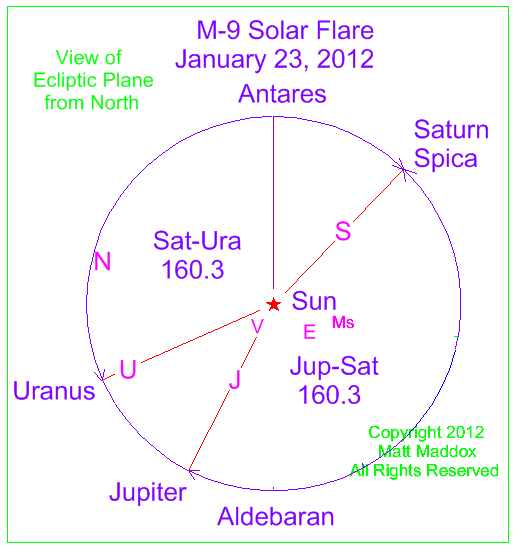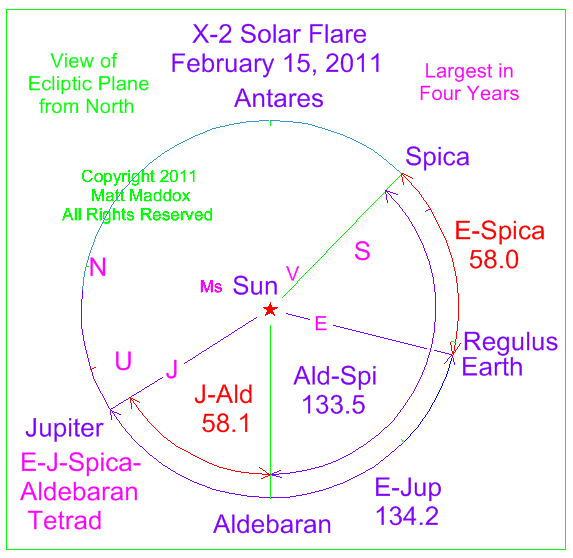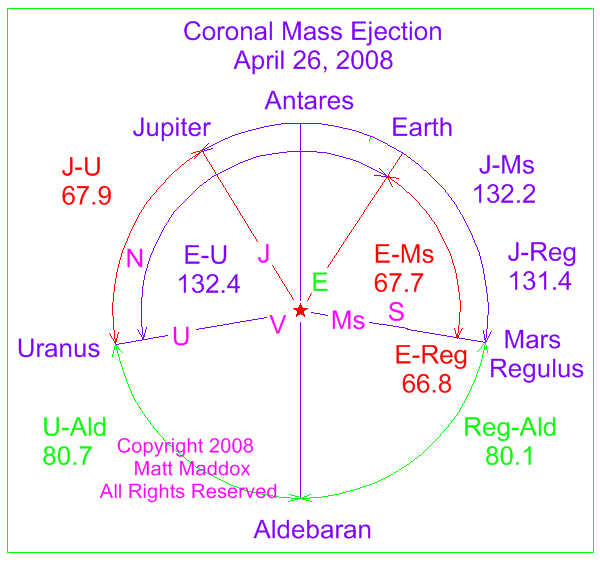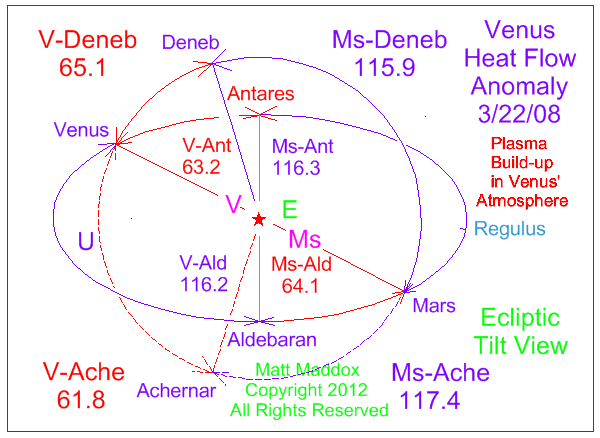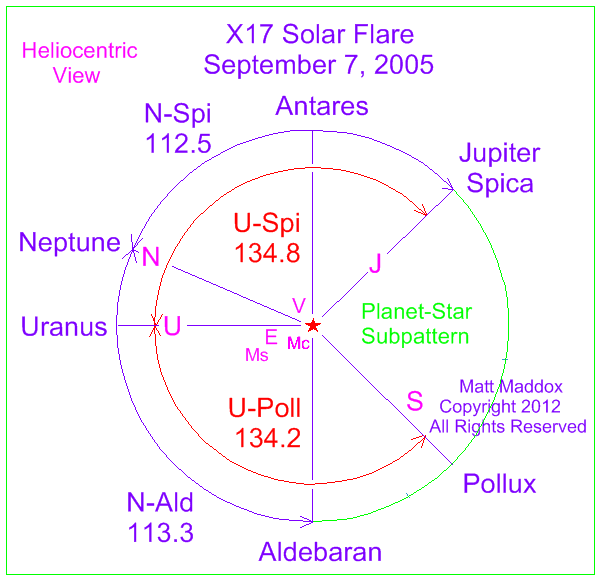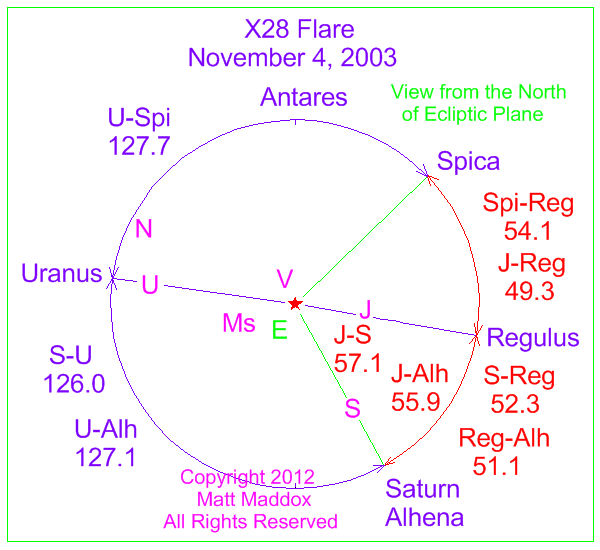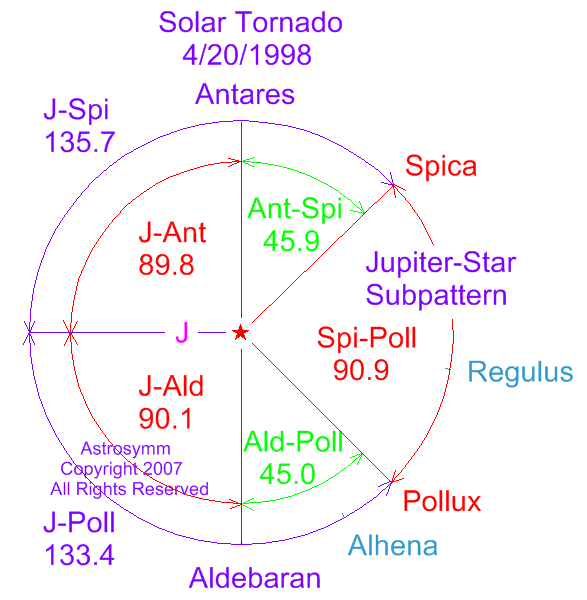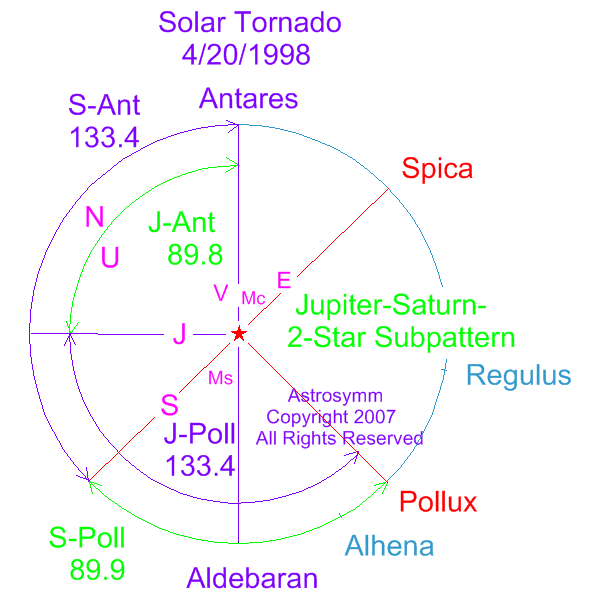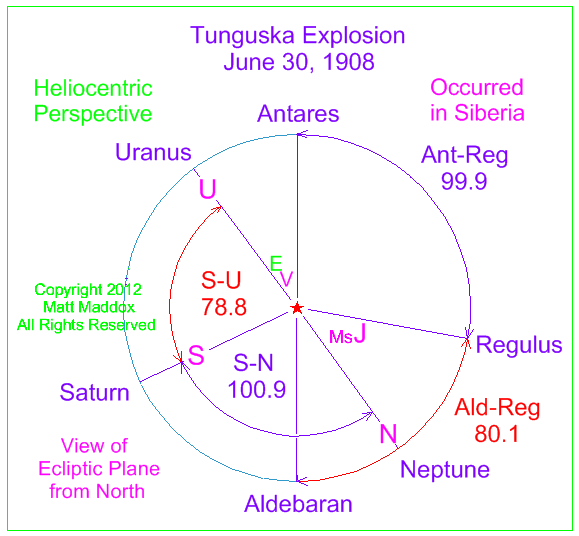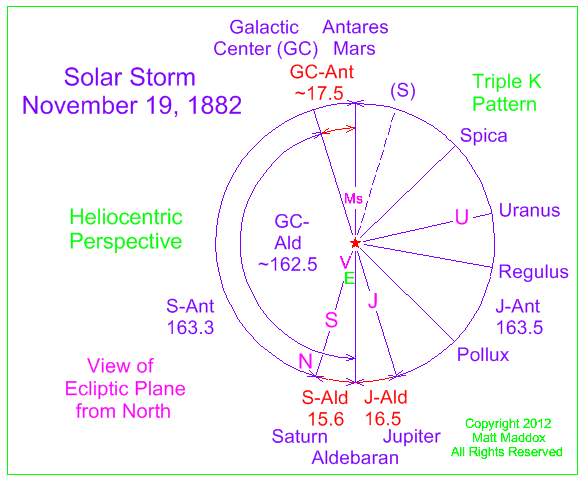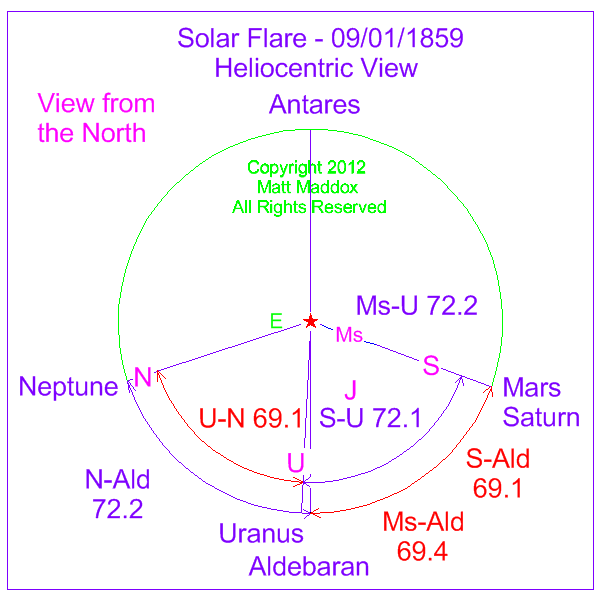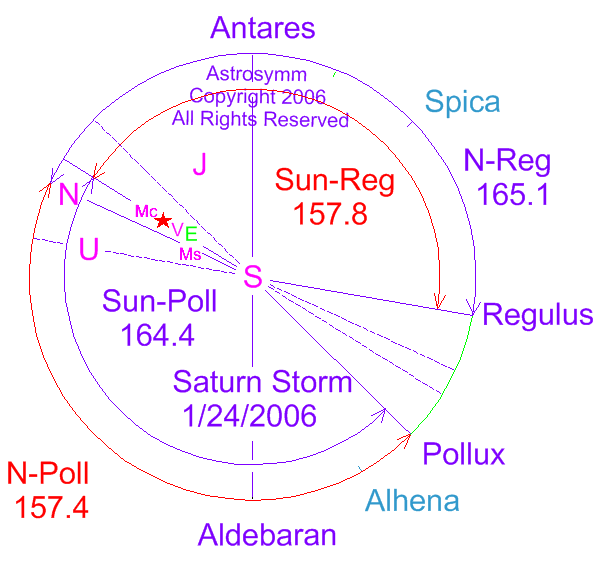| solar system | |||||||||||||||||||||||||||||||||||||||||||||||||||||||||||||||||||||||||||||||||||||||||||||||||||||||||||||||||||||||||||||||||||||||||||||||||||||||||||||||||||||||||||||||||||||||||||||||||||||||||||||||||||||||||||||||||||||||||||||||||||||||||||||||||
|
click here for questions or comments SUN
Uploaded 2024-09-29 X4.5 SOLAR FLARE September 14, 2024
Note the Mars-Uranus angular separation of 0.4 degrees. From the heliocentric viewpoint there was a tetrad or group of four axes which composed a tight symmetric astronomical framework: Antares, Saturn, Mars-Uranus and Regulus.
Uploaded 2024-07-29 X14 SOLAR FLARE July 23, 2024
The Jupiter-Saturn-Spica Symmetry reinforces the Sun-Spica Axis. The Uranus-Neptune-Spica Symmetry also contributes to this Sun-Spica Axis reinforcement. The Ecliptic Symmetric K pattern of Antares, Aldebaran, Pollux and Spica is then reinforced to produce a powerful concentration of energy on the Sun's surface - a rare X14 Solar Flare.
Large Planet Orbital Periods and the Sunspot Cycle Copyright 2018 Matt Maddox All Rights Reserved Uploaded March 16-17, 2018 UTC
Fractional orbital periods of the large planets are calculated for various portions or multiples of the 22-year solar cycle. The sums for these fractions are then tallied and patterns appear at regular intervals of the solar cycle. These sums tally at whole odd numbers for the 22-year cycle. They tally at whole plus half numbers for the 11-year cycles in between the 22-year points. At 5.5-year increments between 11 and 22 years the totals are either whole plus 1/4 or whole plus 3/4. Hypothesis- The planets send out gravitational signals in all directions. These signals will vary depending upon the tilt orientation of the transmitting body to the receiving body. For example, Uranus would send out one signal when its equator is oriented toward the Sun. But it would send out more of a torque signal when it has a polar orientation. These signals or signatures will vary incrementally as the planet revolves around the Sun. Together, the large planets function in unison just like the gears found in a watch or precision timepiece. They also have ratios one to the other just like gears in a watch. The orbital ratio of Jupiter to Saturn to Uranus to Neptune is 15:6:2:1. This is reflected in the 5.5 year column if the Best Fit Fractions are converted to thirty-seconds. Meanwhile, the Sun has a multiplier mechanism based on nuclear reactions such that the signal received is amplified even if the signal is received from Neptune at 30.1 AU. The amplified signals then interact within the Sun to produce the various patterns of sunspots or no spots at all.
12/21/12 update - spaceweather.com shows numerous coronal mass ejections (cmes) for 12/20 & 12/21 on the farside of the sun. sunspot group including #'s 1633 & 1634 will face earth about dec 22. high risk period proceeds through dec 23. this includes neutron radiation associated with solar proton events(spes) and thermal radiation associated with cmes.
12/16/12 update - a sunspot group has emerged on the earth-side of the sun. if this group persists, it will directly face earth on dec 21. watch for coronal mass ejections (cmes) to increase in frequency on dec 18-19. glancing blows from geoeffective cmes could begin as early as dec 19. an archive search of spaceweather.com for dec 15 will show this sunspot group. nasa does not endorse private websites.
plasma event october 2, 2012 same basic pattern compared with december 2012 mayan prediction date heliocentric view there are four states of matter - solid, liquid, gas and plasma. in a gas, like steam, the molecules bounce around and hit each other energetically, but intact. in plasma, the energy level is so high that inner and outer (valence) electrons are stripped from their associated nuclei. the sun was streaming out plasma energy in the form of circular pulses on this date. and earth was lined up with uranus, reinforcing the main pattern evident on the december 21 mayan prediction date. this is the first of four episodes before the dec 21 date in which the tetrad symmetry of uranus, aldebaran-jupiter-antares, regulus-neptune and saturn is reinforced either by earth or venus. the other dates are oct 25, nov 12 and dec 1. please see mayan page for the dec 18-21 solar pattern.
large loop prominence plus coronal mass ejection november 16, 2012 please note seven bodies on four axes plus the subpattern in the inset. earth is symmetrically opposite the galactic center and both bodies are symmetric with the long-term stellar k.
x8 flare and/or cme predicted for september 30 cme occurred september 28 this was a particularly large cme - coronal mass ejection. it is depicted on spaceweather.com. there are four axes involved, three alignments and seven bodies- a very potent combination! according to spaceweather.com, the strong geomagnetic storm it stimulated on september 30 resulted in auroras in northern states and some midwest states!
coronal mass ejection - cme november 9, 2012 note the similarity between this cme and the plasma event on oct 2. there is a simple substitution of mercury for the earth position. there have been 5 different dynamic events/dates in fall of 2012 which show reinforcement or augmentation of the dec 21 mayan symmetric pattern: solar - 1) sept 28 hemispheric cme, 2) oct 2 plasma event 3) nov 9 cme earth - 4) oct 28 canada earthquake & hurricane sandy and 5) guatemala earthquake.
heliocentric angular separations for 2012/08/04 - 1400 utc
coronal mass ejection august 4, 2012 heliocentric view solar event predicted for 1300 utc spaceweather.com calls this a massive coronal mass ejection.
fast coronal mass ejection july 23, 2012 heliocentric view note the symmetric tetrad of axes: uranus, jupiter, regulus (v, n) and spica-saturn.
solar flare/coronal mass ejection predicted for july 14, 2012 - occurred july 12 heliocentric view earth and saturn set up a tight symmetry with the antares-aldebaran axis as shown on the diagram. this is one of several subpatterns for this event. venus and uranus also set up an approximate 64/116 degree symmetry with the same stellar axis on this date. in addition the v-j angle was 104.7 degrees and the v-s angle was 104.9!
solar flare/coronal mass ejection predicted for april 15, 2012 - occurred april 16 heliocentric view the regular stellar ecliptic k pattern composed of antares, aldebaran, spica and pollux is enhanced at the time of this event. from the sun's point of view, earth, saturn and spica are all in close alignment. however, both earth and saturn have passed spica slightly so that a very tight symmetry is formed between two pairs of axes: antares-pollux at 136.7 degrees angular separation and earth/saturn-aldebaran at 136.x degrees as shown. this subpattern shows that earth actually participates in the generation of the solar event! another significant subpattern - not shown - is the tetrad composed of jupiter, uranus, antares and earth/saturn/spica. a solar event was predicted for april 15, 2012 at 1800 utc. this event occurred on april 16 at 1745 utc. watch this impressive eruption on spaceweather.com.
x5 solar flare march 7, 2012 heliocentric view this is an aldebaran-spica tetrad of axes. the tetrad is composed of aldebaran, mercury-venus, earth-mars and saturn-spica. this means that of four axes, three are made up of alignment pairs from the sun's point of view. the axes form a geometric or symmetric pattern in which the mercury-venus and earth-mars axes are symmetric with the aldebaran and saturn-spica axes. on earth, symmetry with aldebaran and spica is typically associated with storms and electromagnetic events such as certain fires, explosions and aviation accidents.
x5 solar flare march 7, 2012 heliocentric view note the almost identical angles of jupiter with antares and also jupiter with saturn-spica - these from the solar point of view.
m-9 solar flare january 23, 2012 heliocentric view note the perfect symmetric planetary pattern with both jupiter and uranus making a 160.3 degree arc with saturn which is in direct alignment with spica.
x-2 solar flare february 15, 2011
intrasite links tropical storms tornadoes solar system
climate/el nino/la nina nuclear power outage/aviation accidents earthquakes/clear air turbulence
coronal mass ejection april 26, 2008 the tetrad producing this event was composed of uranus, jupiter, earth and mars/pollux. please note the excellent agreement in angular separation of the two symmetric pairs - only 2/10 of one degree!
venus heat flow anomaly march 22, 2008 heliocentric view this solar pattern caused a build-up of plasma heat in the atmosphere of venus. please compare to the 3d diagram of the massive 1815 tambora volcanic eruption and the 2003 columbia tragedy.
x17 solar flare september 7, 2005 heliocentric view
x28 flare november 4, 2003 although there were 6 bodies involved in this subpattern, note the simplicity - this is a triad of axes. the triad consists of uranus-sun-jupiter-regulus, sun-saturn-alhena and sun-spica. the device on the solar satellite which measured this event pegged at x28. however, later calculations showed this was an x45 flare! during the 2012-2013 solar maximum neptune is in the position opposite regulus.
solar tornado heliocentric view on april 20, 1998 a tornado on the sun was observed by scientists with nasa and esa. jupiter and saturn were just at the points which could set up planet-star symmetries.
tunguska explosion june 30, 1908 there is a constant (approximate) 80/100 degree stellar pattern in the ecliptic plane composed of aldebaran, regulus and antares. note the 79/101 planetary pattern which mimics the stellar pattern and also overlaps it. the 79/101 pattern is composed of saturn, uranus and neptune. these are also the main components associated with the 1859 solar flare (see below).
prolonged solar storm november 1882 from the viewpoint of the sun, there is a triple-k symmetry centered about the antares-aldebaran axis. uranus is symmetrically opposite regulus and spica is symmetrically opposite pollux. jupiter is simply opposite gc- the center of the galaxy and saturn is symmetrically opposite both jupiter and gc.
coronal mass ejection visible during solar eclipse july 18, 1860
1859 solar flare the carrington flare heliocentric view september 1, 1959
two separate astronomers observed a major solar flare on september 1, 1859. (1) at that time, jupiter was in line with alhena. mars, saturn and neptune formed a perfectly symmetric pattern with uranus and aldebaran.
(1) v.20, monthly notices of royal astronomical society
22 year sunspot cycle controlled by saturn/uranus 1/4 cycles gleissberg 88-year sunspot cycle linked to half/whole cycles of large planets syzygy is the periodic lineup of large planets about every 178 years. saturn and uranus show oscillations very close to 1/4 cycles every 22 years right up to syzygy. this 22 year period allows saturn and uranus to do a dance in which they can alternate polar and equatorial presentations. if uranus starts at a polar facing towards the sun, saturn can show an equatorial face. at 22 years, uranus will transition to equatorial and saturn will make its most polar presentation. jupiter will be at almost a repeat tilt relative to the orientation at start. and neptune generally will not have much effect on the 22 year cycle, since it only moves about 1/8 of its orbital cycle. note the 88 year cycle values for the large planets. gleissberg proposed that there was an 88 year sunspot cycle (1). at this point, saturn and uranus show whole cycles and jupiter and neptune each do a flip in the sky relative to the point of initiation 88 years earlier. these reverses show that an object on the same axis but opposite direction will have the same effect. another good example of this reverse with the same effect is demonstrated with the 1470 year terrestrial climate cycle. at the 1470 year mark jupiter, saturn and neptume all show whole cycles plus 9/10 - in other words, almost whole cycles. uranus shows whole cycles plus a half cycle. yet the effect is the same - there is a climate repeat at the 1470 year mark.
(1) peristykh, a. n., and p. e. damon (2003), persistence of the gleissberg 88-year solar cycle over the last 12,000years: evidence from cosmogenic isotopes, j. geophys. res., 108(a1), 1003, doi:10.1029/2002ja009390. (2) www.ncpa.org/pub/st/st279 p5-6 the physical evidence of earth's unstoppable 1500-year climate cycle, s fred singer, dennis t avery, article from book by authors, ncpa policy report no. 279, sept 2005, isbn #1-56808-149-9, national center for policy analysis, dallas, tx, authors reference this author/article: gerard bond et al., “a pervasive millennial-scale cycle in north atlantic holocene and glacial climates,” science, vol. 278, no. 5341, november 14, 1997, pages 1257–1266.
saturn
saturn storm - january 24, 2006 the january 2006 storm (1) on saturn shows definite symmetry also. on that day saturn experienced line-ups along four different axes. uranus-saturn-regulus was one alignment, neptune-mars-saturn was the second and mercury-sun-venus-earth-saturn was the third. the two-body saturn-pollux line made up a fourth axis and completed a very neat 4-axis symmetry.
(1) lightning sounds from saturn. nasa press release. february 14, 2006 www.nasa.gov/mission_pages/cassini/multimedia/ pia02166.html
|
|||||||||||||||||||||||||||||||||||||||||||||||||||||||||||||||||||||||||||||||||||||||||||||||||||||||||||||||||||||||||||||||||||||||||||||||||||||||||||||||||||||||||||||||||||||||||||||||||||||||||||||||||||||||||||||||||||||||||||||||||||||||||||||||||
copyright 2007 astrosymm
all rights resrved

